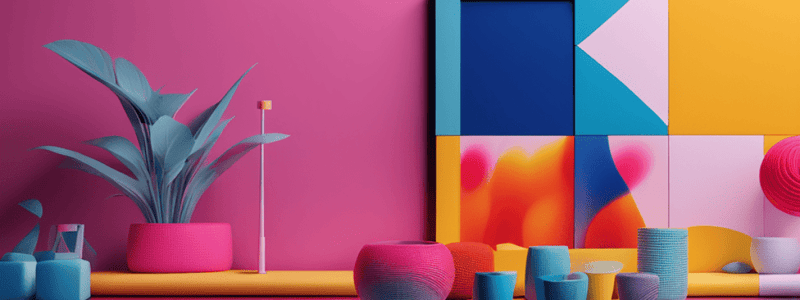Podcast
Questions and Answers
What color is the sun
What color is the sun
yellow (A)
Color temperature refers to the relative warmth or coolness of a color.
Color temperature refers to the relative warmth or coolness of a color.
True (A)
Analogous colors are colors that are adjacent on the color wheel.
Analogous colors are colors that are adjacent on the color wheel.
True (A)
Using monochromatic colors means using a single color palette with varying saturation and brightness.
Using monochromatic colors means using a single color palette with varying saturation and brightness.
Experimenting with various methods of mixing colors is not recommended for achieving desired visual effects.
Experimenting with various methods of mixing colors is not recommended for achieving desired visual effects.
Blue in Vincent van Gogh's 'Starry Night' represents the energy and movement of the stars.
Blue in Vincent van Gogh's 'Starry Night' represents the energy and movement of the stars.
In Hinduism, the color orange is associated with spiritual growth and wisdom.
In Hinduism, the color orange is associated with spiritual growth and wisdom.
In Christian symbolism, red is used to represent purity.
In Christian symbolism, red is used to represent purity.
People often wear specific colors to express mourning in social contexts.
People often wear specific colors to express mourning in social contexts.
Colors are only decorative elements and do not carry any symbolic meanings.
Colors are only decorative elements and do not carry any symbolic meanings.
Flashcards are hidden until you start studying
Study Notes
Exploring the Art of Color Mixing
Color is a fundamental element of our visual world, and understanding how colors interact with one another is a fascinating aspect of art, design, and everyday life. In this article, we'll delve into the art of color mixing, a skill that allows us to create an endless array of new hues by blending existing colors.
Primary Colors
At the heart of color mixing lie the three primary colors: red, blue, and yellow. These colors, when combined, create secondary colors (green, orange, and purple), which in turn can be mixed to create tertiary colors.

Additive and Subtractive Color Systems
There are two primary color systems: additive and subtractive. In the additive system, combinations of red, green, and blue (RGB) light are used to create colors on screens, while in the subtractive system, pigments made from red, blue, and yellow (CMY) are combined to create colors when printed or painted.
Color Mixing Methods
Color mixing can be achieved through various methods, including:
- Overlapping: Layering one color over another to create new hues; for instance, applying blue over yellow produces green.
- Direct mixing: Blending colors, either by mixing them on a palette or directly on a surface, such as canvas or paper.
The Color Wheel
The color wheel, also known as an HSB (Hue-Saturation-Brightness) wheel, is a graphic organizer that displays colors in a circular arrangement. The wheel is divided into 12 segments, each labeled with the color it represents. The primary colors (red, blue, and yellow) are located at 120-degree intervals, and secondary and tertiary colors are interspersed between them.

The Color Temperature
Color temperature is a measure of the relative warmth or coolness of a color. Warm colors (red, orange, and yellow) are associated with energy and warmth, whereas cool colors (blue, green, and purple) are linked with calmness and tranquility. An understanding of color temperature can help you create balanced and harmonious compositions.
Color Harmony
Color harmony refers to the pleasing relationship between colors in a design. There are several methods of achieving color harmony:
- Complementary colors: Choosing colors that are opposite each other on the color wheel (orange and blue, for example) to create high contrast and visual interest.
- Analogous colors: Selecting colors that are adjacent on the color wheel (red-orange and orange-yellow) to create a smooth transition between hues.
- Monochromatic colors: Limiting the color palette to a single color, but varying its saturation and brightness to create different shades and tints.
Color Mixing Tips
- Start with small amounts of color and gradually add more to achieve your desired effect.
- Be mindful of the color temperature and compatibility of the colors you're mixing.
- Experiment with various methods of mixing colors, such as overlapping, direct mixing, and glazing.
- Pay attention to the proportion of colors in your composition to achieve the desired visual effect.
Conclusion
Color mixing opens a world of creative possibilities, enabling us to create countless new hues and explore the nuances of color. Understanding the primary, secondary, and tertiary colors, as well as the color wheel and color temperature, is essential to creating harmonious compositions and deepening your appreciation for the beauty of color.
Studying That Suits You
Use AI to generate personalized quizzes and flashcards to suit your learning preferences.




